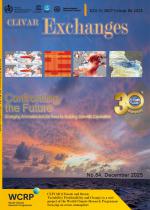MHW Summer School Reading Material
ICTP/CLIVAR Summer School on Marine Heatwaves: Global Phenomena with Regional Impacts
Reading Materials
Note: Please contact the the Secretariat via jing.li@clivar.org or smr3857@ictp.it if you have difficulty in accessing to the papers.
Day 1: Detection
Priority: (*Please read before the session)
Amaya D. et al., (2023) Marine heatwaves need clear definitions so coastal communities can adapt, Nature, 616:29-32, https://doi.org/10.1038/d41586-023-00924-2
Elzahaby Y. and A. Schaeffer (2019) Observational Insight Into the Subsurface Anomalies of Marine Heatwaves. Front. Mar. Sci. 6:745. https://doi.org/10.3389/fmars.2019.00745
Hobday A. et al. (2016) A hierarchical approach to defining marine heatwaves, Progress in Oceanography, 141:227-238, https://doi.org/10.1016/j.pocean.2015.12.014
Schlegel R.W. et al (2021) Marine cold-spells, Progress in Oceanography, 198:102684,https://doi.org/10.1016/j.pocean.2021.102684
More references:
Hobday A. et al. (2018) Categorizing and Naming Marine Heatwave, Oceanography, 31(2): 162-173, https://www.jstor.org/stable/26542662
Day 2: Mechanisms
Priority: (*Please read before the session)
Capotondi, A., Newman, M., Xu, T. and Di Lorenzo, E. (2022) An optimal precursor of Northeast Pacific marine heatwaves and Central Pacific El Niño events. Geophysical Research Letters, 49:e2021GL097350. https://doi.org/10.1029/2021GL097350
Holbrook N.J. et al. (2019), A global assessment of marine heatwaves and their drivers, Nature Communications, 10:2624, https://doi.org/10.1038/s41467-019-10206-z
Rodrigues et al. (2019) Common cause for severe droughts in South America and marine heatwaves in the South Atlantic, Nature Geoscience, 12:620-626, https://doi.org/10.1038/s41561-019-0393-8
Stefanon et al. (2012) Heatwave classification over Europe and the Mediterranean region, Environ. Res. Lett. 7:014023,https://doi.org/10.1088/1748-9326/7/1/014023
More references:
Amaya, D.J., Miller, A.J., Xie, S.P. and Kosaka, Y. (2020) Physical drivers of the summer 2019 North Pacific marine heatwave. Nature Communications, 11:1903. https://doi.org/10.1038/s41467-020-15820-w
Benthuysen, J., Feng, M., & Zhong, L (2014). Spatial patterns of warming off Western Australia during the 2011 Ningaloo Niño: Quantifying impacts of remote and local forcing. Continental Shelf Research, 91:232-246. http://dx.doi.org/10.1016/j.csr.2014.09.014
Bond, N.A., Cronin, M.F., Freeland, H., & Mantua, N. (2015). Causes and impacts of the 2014warm anomaly in the NE Pacific, 2015. Geophysical Research Letters, 42:3414-3420. https://doi.org/10.1002/2015GL063306.
Chen, K., Gawarkiewicz, G., Kwon, Y.-O., & Zhang, W., (2015) The role of atmospheric forcing versus ocean advection during the extreme warming of the Northeast U.S. continental shelf in 2012. JGR Oceans, 120:4324-4339. https://doi.org/10.1002/2014JC010547.
Gregory, C.H., Holbrook. N.J., Marshall, A.G., & Spillman, C.M., 2023. Atmospheric drivers of Tasman Sea marine heatwaves. Journal of Climate, https://doi.org/10.1175/JCLI-D-22-0538.1.
Kajtar et al. (2022), Drivers, Dynamics, and Persistence of the 2017/2018 Tasman Sea Marine Heatwave, JGR Ocean, 127, e2022JC018931. https://doi.org/10.1029/2022JC018931
Scannell et al. (2020) Subsurface Evolution and Persistence of Marine Heatwaves in the Northeast Pacific, Geophysical Research Letters, 47:e2020GL090548. https://doi.org/10.1029/2020GL090548
SenGupta et al. (2020), Drivers and impacts of the most extreme marine heatwave events, Scientific Reports, 10:19359, https://doi.org/10.1038/s41598-020-75445-3
Wang, Y., N. Holbrook, and J. Kajtar, (2023) Predictability of Marine Heatwaves off Western Australia using a Linear Inverse Model. J. Climate, https://doi.org/10.1175/JCLI-D-22-0692.1.
Full list of readings: https://drive.google.com/file/d/1ZaUFTzXgJJgW3cT10QIMx2DyPTSwjJ7w/view?usp=drive_link
Day 4: Projections
Priority: (*Please read before the session)
Deser et al. (submitted) Future changes in the Intensity and Duration of Marine Heat and Cold Waves: Insights from Coupled Model Initial-Condition Large Ensembles (pdf)
Frölicher et al. (2018) Marine heatwaves under global warming, Nature, 560:360-364, https://doi.org/10.1038/s41586-018-0383-9
Gruber et al. (2021) Biogeochemical extremes and compound events in the ocean. Nature. 600:395-407, https://doi.org/10.1038/s41586-021-03981-7
Laufkötter et al. (2020) High-impact marine heatwaves attributable to human-induced global warming, Science, 369:1621-1625, https://doi.org/10.1126/science.aba0690
More references:
Burger F.A., J. Terhaar, and T.L. Frölicher (2022) Compound marine heatwaves and ocean acidity extremes, Nature Communications, 13:4722, https://doi.org/10.1038/s41467-022-32120-7
Deser et al. (2020) Insights from Earth system model initial-condition large ensembles and future prospects, Nature Climate Change, 10:277-286, https://doi.org/10.1038/s41558-020-0731-2
Stott et al. (2016) Attribution of extreme weather and climate-related events, WIREs Climate Change, 7:23-41, https://doi.org/10.1002/wcc.380
Xu et al. (2022) An increase in marine heatwaves without significant changes in surface ocean temperature variability, Nature Communications, 13:7396, https://doi.org/10.1038/s41467-022-34934-x











Add new comment